This review was one of the finalists in Circa’s critical-writing competition for undergraduates in Ireland; more information here .
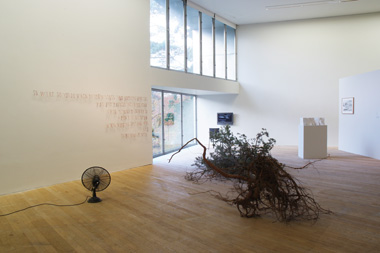 |
| Gallery 1 Lewis Glucksman Gallery, installation Image featuring Clodagh Emoe: Point of no return, 2005, and Johan Thurfjell: Patajonia, 2006; courtesy Lewis Glucksman Gallery |
Such are the prosaic delights that await the viewer in the retro 1960s Glucksman, replete with spelling and grammatical errors that could so easily be spotted by any six-year-old child who has recently completed their grammar classes and spelling tests.
Wandering directionless, in an aimless manner, the first haunting eerie sound of a ram’s horn in the synagogue on the observance of Yom Kippur assaults the ears, and turning a corner I discover the ludicrous sight of a dull neon bulb slowly melting to the side of a video installation installed for the benefit of ‘oompa loompas’ on the rather dusty and terribly off-white walls; the screen flickers at my feet with the barely imperceptible (or should I say ridiculous) images of Kathy running around the woods to the sound of a screeching, ear-rattling horn and dressed in what looks to be a kagool. This all takes place in an installation that would not be out of place for an IKEA set.
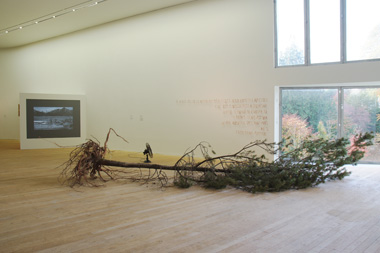 |
| Gallery 1 Lewis Glucksman Gallery, installation image featuring Clodagh Emoe: Point of no return, 2005, and Rachel Reupke: Infrastructure, 2002; courtesy Lewis Glucksman Gallery |
I swiftly move past some Leaving Cert art to the familiar sight of a dead Christmas tree with some tinsel stuck on the walls, or at least that’s what it appears to be; on closer inspection, it is a message: each individual letter is pinned on the wall, being blown by a fan on the floor. The text is that long and annoying to read that one gives up any interest in the message the artist is attempting to convey.
 |
| Sven Johne: from A Walk in Lusatia, 2006; courtesy Lewis Glucksman Gallery |
From that, one is presented with an installation that is a reminder that you are in the city, with the video of traffic moving through the countryside. If only a bogger was standing alongside it to explain just how much he achieved for his land when he sold it for the building of the outer ring. Oh, what tragedy that I’d never had insight into before.
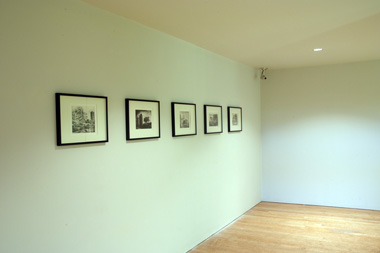 |
| Lewis Glucksman Gallery, installation image featuring Cyprien Gaillard : Belief in the age of disbelief, 2005; courtesy Lewis Glucksman Gallery |
 |
| Olaf Quantius: Wellblechhütte, 2007; courtesy Lewis Glucksman Gallery |
Moving sullenly up the stairs – which incidentally are made of the most beautiful untarnished wood, completing the ‘White Cube’ rule – I suddenly realise that I have missed one third of the exhibition because at the top of the stairs, I really should have turned right. However, moving on up (like an ill-fated pop tune), a boring set of etchings of skyscrapers à la Dürer greets my eyes. But if, like me, you have ever been to an art gallery before, you will most certainly have seen all this before. Something new brings on a groan of exasperation: a room, entirely taken up, relating to nothing other than its square blandness, chalk marks on the wall, bits of broken glass or Perspex, scrawly drawings, an open book on the floor and a pile of turf briquettes adhered to the wall. It resembled the back of any inner-city Tesco. I was unsure whether or not to take a piece of turf home with me, as it appeared to be the only item within the room of any use and / or interest.
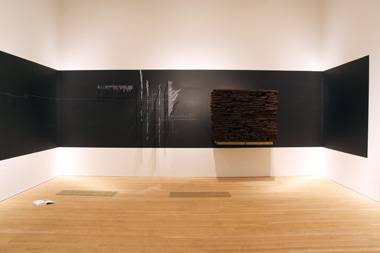 |
| Gallery 2, Lewis Glucksman Gallery, installation image featuring Daniel Roth: A history of echoes of places, 2007; courtesy Lewis Glucksman Gallery |
 |
| Sisk Gallery, Lewis Glucksman Gallery, installation image featuring David Claerbout: Ruurlo, Bocurloscheweg, 1910, 1997; courtesy Lewis Glucksman Gallery |
In another little room, dark and stuffy, an ancient photograph comes to life with the waving of leaves. The information tells me it “juxtaposes reality and unreality of the profundity”; I leave it running into infinity. To sit through the sheer boredom of a demonic farmer driving his tractor, possibly named Christine, as he rapes the earth somewhere near the vicinity is beyond words. Possibly a farmers ‘action movie’, it was, however, uninspired drivel.
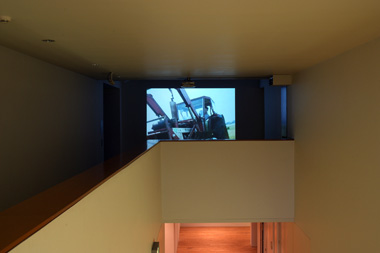 |
| Gallery 2, Lewis Glucksman Gallery, installation image featuring John Bock: Trecker, 2003; courtesy Lewis Glucksman Gallery |
Being careful not to break the neon bulbs under the lava rocks placed ever so discreetly on the floor, one can wander past what appears to be Japanese watercolours of corrugated huts and on the opposite wall, infrared pictures give us an insight into every piece of turf I have ever known; adjacent to this, and behind another black curtain, permeated with the heavy smell of halitosis, a video installation (yes, another one) takes me on a balloon ride in an artistic effort so subjective it only relates to the artist and her sentimentalist claptrap.
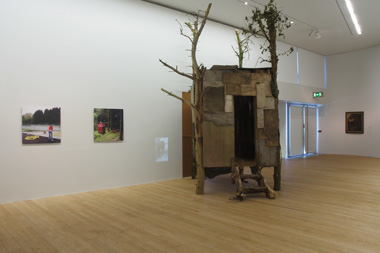 |
| Gallery 2 Lewis Glucksman Gallery, installation image featuring Patrick Feehan: Untiltled 2007; courtesy Lewis Glucksman Gallery |
 |
| Gallery 2 Lewis Glucksman Gallery, installation image featuring Patrick Feehan: Untiltled 2007;, Dara McGrath: photographs form the Plantation series 2003, and Stephen Brandes: Yammerstadt 2007; courtesy Lewis Glucksman Gallery |
One item stands high above the rest: an installation in which a man sits bellowing at nature (Richard T Walker, Successive inconceivable events). He almost begs it to love him but, amid the vacuous space of the scenery and gallery, his words alone ring true; there is no love here, no aesthetic to move the soul, only turgid observations of the most banal kind.
 |
| Gallery 1, Lewis Glucksman Gallery, installation image featuring James Ireland: Straight lines are curves from very large circles, 2005, James Ireland: Measured objective, 2007, Walter W Russell: A Country lane, and Richard Wilson: Landscapes with figures; courtesy Lewis Glucksman Gallery |
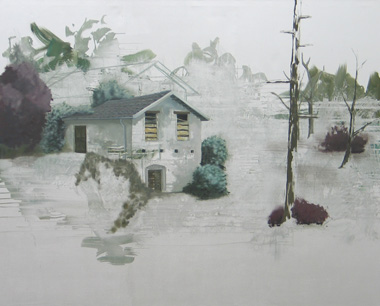 |
| Olaf Quantius: Hegenheim II, 2006; courtesy Lewis Glucksman Gallery |
Having had more than enough, and waltzed past the sentimental drivel disguised as art from latter centuries, I had to pay homage to the book store, with its clatter of trinkets for the faithful pilgrims. Puzzles and children’s toys were mixed together with books on art, no doubt in some meaningful way. I spied its saving grace amidst the madness, a treasure trove of books to feed my seemingly endless curiosity, which caused me to ponder on how many trees had been slayed to slake my thirst of art. But a word to the wise, and the wary traveller: ‘No book tokens please, cash only’
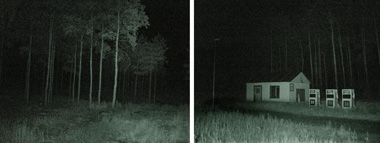 |
| Sven Johne: from A Walk in Lusatia, 2006; courtesy Lewis Glucksman Gallery |
Wandering through the now overly familiar exhibition in order to get to the exit, one cannot help but muse on the pointlessness of my morning, the aimless exhibition that trudges through the mud and drudgery I’ve known before. It is a shame the exhibition is not something more worthwhile, in such a splendid space. The Glucksman Gallery itself is rather marvellous; however, the choice of works that were in this exhibition (I cannot feel anything but relief that it is not permanent) is disappointing. Being such a young building, it is only starting and will hopefully find its own niche in the echelons of this Irish art world.
Stuart Harrison